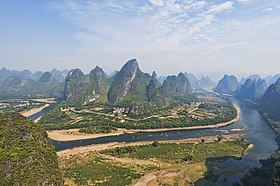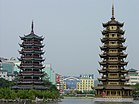You can help expand this article with text translated from the corresponding article in Chinese. (July 2014)Click [show] for important translation instructions.
|
Guangxi 广西 Kwangsi | |
|---|---|
| Guangxi Zhuang Autonomous Region | |
| Chinese transcription(s) | |
| • Pinyin | Guǎngxī zhuàngzú zìzhìqū |
| • Jyutping | Gwong2 sai1 Zong3 zuk6 Zi6 zi6 keoi1 |
| • Abbreviation | 桂 (Guì; Gwai3) |
| Zhuang transcription(s) | |
| • Standard Zhuang | Gvangjsih Bouxcuengh Swcigih |
| • Abbreviation | Gvei |
Clockwise from the top: | |
 Location of Guangxi within China | |
| Country | China |
| Named after |
|
| Capital (and largest city) | Nanning |
| Divisions | 14 prefectures, 109 counties, 1396 townships |
| Government | |
| • Type | Autonomous region |
| • Body | Guangxi Zhuang Autonomous Regional People's Congress |
| • Party Secretary | Chen Gang |
| • Congress Chairman | Liu Ning (titular) |
| • Government Chairman | Lan Tianli |
| • CPPCC Chairman | Sun Dawei |
| • National People's Congress Representation | 89 deputies |
| Area | |
• Total | 237,600 km2 (91,700 sq mi) |
| • Rank | 9th |
| Highest elevation | 2,141 m (7,024 ft) |
| Population (2020) [1] | |
• Total | 50,126,804 |
| • Rank | 11th |
| • Density | 210/km2 (550/sq mi) |
| • Rank | 20th |
| Demographics | |
| • Ethnic composition | |
| • Languages and dialects | Zhuang, Yue languages (mainly Cantonese), Southwestern Mandarin, Pinghua |
| ISO 3166 code | CN-GX |
| GDP (2023) [2] | CN¥ 2,720 billion (19th) US$ 386 billion |
| GDP per capita | CN¥ 54,005 (29th) US$ 7,664 |
| GDP per growth | |
| HDI (2022) | 0.751 [3] (26th) – high |
| Website | (in Chinese) Guangxi Zhuang Autonomous Region |
- ↑ /ɡwɑːŋˈʃiː/ , gwahng-SHEE; [kwàŋ.ɕí] ⓘ ; alternately romanized as Kwangsi or Kwanghsi; Chinese :广西; Zhuang: Gvangjsih
- ↑ New district established after 2010 census: Wuming (Wuming County). The new district not included in the urban area count of the pre-expanded city.
- ↑ New district established after 2010 census: Liujiang (Liujiang County). The new district not included in the urban area count of the pre-expanded city.
- ↑ New district established after 2010 census: Lingui (Lingui County). The new district not included in the urban area count of the pre-expanded city.
- ↑ New district established after 2010 census: Longxu by splitting from parts of Cangwu County. The new district areas from Cangwu County not included in the urban area count of the pre-expanded city.
- ↑ New district established after 2010 census: Pinggui by splitting from parts of Zhongshan County and parts of Babu. The new district areas from Zhongshan County not included in the urban area count of the pre-expanded city.
- ↑ New district established after 2010 census: Tianyang (Tianyang County). The new district not included in the urban area count of the pre-expanded city.
- 1 2 New district established after 2010 census: Yizhou (Yizhou CLC). The new district not included in the urban area count of the pre-expanded city.
- ↑ Pingguo County is currently known as Pingguo CLC after 2010 census.
- ↑ Jingxi County is currently known as Jingxi CLC after 2010 census.
- ↑ Lipu County is currently known as Lipu CLC after 2010 census.
Demographics
| Guangxi | |
|---|---|
 Guangxi in simplified (top) and traditional (bottom) characters |
| Year | Pop. | ±% |
|---|---|---|
| 1912 [29] | 7,879,000 | — |
| 1928 [30] | 13,648,000 | +73.2% |
| 1936–37 [31] | 13,385,000 | −1.9% |
| 1947 [32] | 14,636,000 | +9.3% |
| 1954 [33] | 19,560,822 | +33.6% |
| 1964 [34] | 20,845,017 | +6.6% |
| 1982 [35] | 36,420,960 | +74.7% |
| 1990 [36] | 42,245,765 | +16.0% |
| 2000 [37] | 43,854,538 | +3.8% |
| 2010 [38] | 46,026,629 | +5.0% |
| 2020 [39] | 50,126,804 | +8.9% |
Ethnic groups
The Han Chinese are the largest ethnic group in Guangxi. Han Chinese populations in Guangxi largely live along the autonomous region's southern coast and eastern portions. [19] Of these, the main subgroups are those that speak Yue and Southwestern Mandarin varieties of Chinese. Qinzhou and Goulou Yue are spoken in the southern and eastern regions, respectively. Pinghua is spoken in Nanning and Guilin. There are Hakka-speaking regions in Luchuan County, Bobai County and in some areas bordering Vietnam.
Guangxi has over 16 million Zhuangs, the largest minority ethnicity in China. Over 90 percent of Zhuang in China live in Guangxi, especially in the central and western regions. High concentrations of Zhuang people can be found in Nanning, Liuzhou, Chongzuo, Baise, Hechi, and Laibin. [19] The highest concentration of ethnic Zhuang people is found in the county-level city of Jingxi, with a 2021 publication by the People's Government of Guangxi stating that Jingxi's population is 99.7% Zhuang. [19]
The autonomous region also has sizable populations of indigenous Yao, Miao, Kam, Mulam, Maonan, Hui, Bouyei, Gin, Yi, Sui and Gelao peoples. [19] [40] Other ethnic minorities in Guangxi include the Manchu, Mongol, Korean, Tibetan, Hlai, and Tujia people. [19]
| Ethnicity | Han Chinese | Zhuang | Yao | Miao | Dong | Mulao | Maonan | Hui | Bouyei | Gin | Other nationalities |
|---|---|---|---|---|---|---|---|---|---|---|---|
| Population | 31,318,824 | 15,721,956 | 1,683,038 | 578,122 | 362,580 | 180,185 | 73,199 | 35,347 | 31,303 | 29,326 | 112,924 |
| Percentage (%) | 62.48 | 31.36 | 3.36 | 1.15 | 0.72 | 0.36 | 0.15 | 0.07 | 0.06 | 0.06 | 0.23 |
| Proportion of minority population (%) | - | 83.59 | 8.95 | 3.07 | 1.93 | 0.96 | 0.39 | 0.19 | 0.17 | 0.16 | 0.60 |
Religion
- Chinese ancestral religion (40.48%)
- Christianity (0.26%)
- Other religions or not religious people [note 2] (59.26%)
The predominant religions in Guangxi among the Han Chinese are Chinese folk religions, Taoist traditions and Chinese Buddhism. The large Zhuang population mostly practices the Zhuang folk religion centered around the worship of their ancestral god Buluotuo (布洛陀). According to surveys conducted in 2007 and 2009, 40.48% of the population believes and is involved in ancestor veneration, while 0.26% of the population identifies as Christian. [42]
The reports did not give figures for other types of religion; 59.26% of the population may be either irreligious or involved in worship of nature deities, Buddhism, Confucianism, Taoism, folk religious sects. The Yao, another numerous ethnic group inhabiting the province, mostly practices a form of indigenised and conservative Taoism.
Today, there are 21 mosques in Guangxi [43] This may include:
- Nanning Mosque
- Guilin Chongshan Mosque
- Guilin Ancient Mosque
- Liuzhou Mosque
- Baise Mosque













